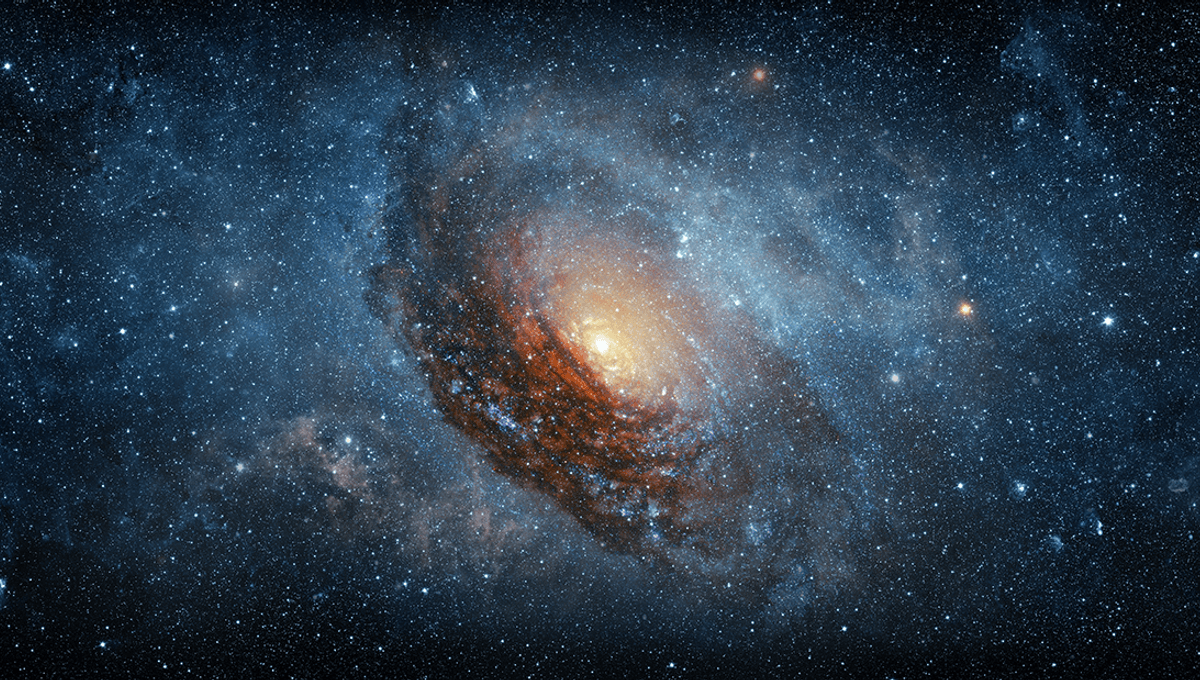A recent paper has proposed a new idea for what is causing the observed accelerated expansion of the universe, and dark matter, suggesting both of them may a "cosmic illusion" caused by the changing constants of the universe.
The rest of this article is behind a paywall. Please sign in or subscribe to access the full content. By observing the universe from the cosmic microwave background to our nearest galaxies, we know that our universe is expanding. Weirder (and subject to further observations and analysis) the expansion appears to have sped up, beginning around 5-6 billion years ago. We call the mysterious influence driving the accelerated expansion dark energy. Dark matter, meanwhile, is invisible matter that doesn't emit its own light and only interacts with normal matter through gravity, which we can see evidence for in galaxies and galaxy clusters. As well as finding evidence for it in the rotation rate of galaxies, and in the bullet cluster, there is evidence for its existence in the gravitational lensing of galaxies. While there are many dark matter candidates, and plenty of experiments looking into it, detection has not yet happened, and we are no closer to figuring out what dark energy is. There's even evidence to suggest it could be evolving. There's a lot to explain, and any new big idea would have to explain a vast amount of observations with it. In a new idea from Rajendra Gupta, adjunct professor in the Department of Physics at the University of Ottawa, the observations can be explained by changes to the strength of the fundamental forces of the universe over time. "The universe's forces actually get weaker on the average as it expands," Gupta said in a statement. "This weakening makes it look like there's a mysterious push making the universe expand faster (which is identified as dark energy). However, at galactic and galaxy-cluster scale, the variation of these forces over their gravitationally bound space results in extra gravity (which is considered due to dark matter). But those things might just be illusions, emergent from the evolving constants defining the strength of the forces." The paper suggests that galaxy rotation curves, gravitational lensing, and dark energy could all be explained with covarying coupling constants (CCC), or the idea that the universe's "constants" like the strength of gravity and electromagnetism change over time, related to each other. In this model, the coupling constants (noted 𝛼) are fixed on cosmological scales, but are allowed to vary locally depending on the distribution of normal baryonic matter. “There are two very different phenomena needed to be explained by dark matter and dark energy: The first is at cosmological scale, that is, at a scale larger than 600 million light years assuming the universe is homogeneous and the same in all directions. The second is at astrophysical scale, that is, at smaller scale the universe is very lumpy and direction dependent. In the standard model, the two scenarios require different equations to explain observations using dark matter and dark energy. Ours is the only one that explains them with the same equation, and without needing dark matter or dark energy," Gupta said. The work predicts that in areas of higher concentration of matter, the contribution from 𝛼 is lower than in areas where there is very little matter or none at all. Effectively, instead of dark matter being responsible for the rotation curves of galaxies, the extra gravity comes from the larger contribution of 𝛼 at a galaxy's edge. According to Gupta, using simplified models this can reproduce galaxy curves without the need for dark matter. “What’s really exciting is that this new approach lets us explain what we see in the sky: galaxy rotation, galaxy clustering, and even the way light bends around massive objects, without having to imagine there’s something hiding out there," Gupta added. "It’s all just the result of the constants of nature varying as the universe ages and becomes lumpy.” While certainly an interesting hypothesis to consider, we should highlight that it is quite out of line with current physics and, as Carl Sagan once said, extraordinary claims require extraordinary evidence, which CCC has not provided as yet. There are also reasons to suspect the idea won't replace the dark energy / cold dark matter model anytime soon. Part of Gupta's model is the idea of "tired light" as a way of explaining redshift of distant galaxies, an idea which is widely regarded as discredited. Gupta made headlines in 2023 with a paper suggesting that the universe is actually 26 billion years old, earning criticism from many in the scientific community. “There are many, many measurements that suggest the age of the universe is about 14 billion years,” Professor Tamara Davis of the University of Queensland told IFLScience. “Not just the cosmic microwave background, not just the expansion rate measured using supernovas, there’s also the large-scale structure of the universe and the measured age of the oldest stars.” “The other issue is that they’ve fitted their model to the supernova data alone,” Davis added of the paper. “It’s just not good enough to fit it to one set of data and ignore all the rest.” “They don’t seem to have done even simple things like see whether their new theory of gravity breaks what we know about the orbits of planets in the solar system,” she added. Nevertheless, Gupta believes that the CCC model could solve this and other puzzles of the universe. “For years, we’ve struggled to explain how galaxies in the early universe formed so quickly and became so massive,” he said. “With our model, you don’t need to assume any exotic particles or break the rules of physics. The timeline of the universe simply stretches out, almost doubling the universe’s age, and making room for everything we observe.” “Sometimes, the simplest explanation is the best one. Maybe the universe’s biggest secrets are just tricks played by the evolving constants of nature." The paper is published in Galaxies.






